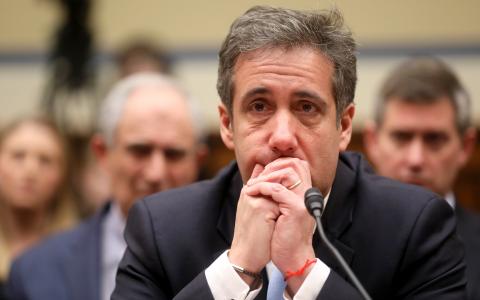
Two years of partisan warfare ahead raise the risk and lower the likely rewards conventional investors can anticipate.
History never repeats, but last week’s Michael Cohen hearing carried a strong echo of Nixon lawyer John Dean and his 1973 testimony.
Dean accelerated what would become a year of turmoil in Washington and ultimately a bigger market crash than what we saw in 2008.
While Cohen probably doesn’t have that much juice, it’s clear that he’s only the overture in what promises to be a long cycle of recrimination and investigation.
The knives are out in Congress. They’re not going back until at least 2020 or they draw blood, whichever comes first.
Wherever your political inclinations are, that’s not a great scenario for investors -- but maybe not for the reasons that many people think.
And from what we can see on the calendar now, it’s not great for advisors either.
From gridlock to grind
Wall Street famously thrives when Washington is too distracted to interfere with the free flow of capital.
Divided government doesn’t pass a lot of big bills to upset the status quo. The votes for sweeping policy moves just aren’t there.
That status quo may or may not be ideal, but it’s as dependable as it gets. People can extrapolate patterns and plan around them.
However, when the gridlock starts feeding on itself, the status quo can actually deteriorate. Important things don’t get done.
We’ve seen hints of this process over the decades as the debt ceiling stays close and shutdowns multiply.
Investigations and impeachment rumors are only symptoms of the larger problem, draining attention and other resources from the work of keeping the economy spinning.
That’s why I suspect the easy Nixon parallels aren’t really useful here.
It’s far too early to say how the Trump presidency will end. What we know now is that the next two years will be a mess of hearings and unblinking oversight -- in short, a compliance nightmare.
Beyond 2020, the game could change again. But in the meantime, pressure builds mistakes and errors of omission.
The distracted Fed
What I’m worried about, to be honest, is an embattled White House leaning on the Fed to ignore inflation.
We know President Trump loves low rates and a hot economy as well as (currently) a relatively soft dollar. As the pressure increases, these easy policies will become an even bigger temptation to keep the public on his side.
Inflation, of course, played a huge role in the 1970s market crash and why it was so difficult for stocks to recover.
Cheap money was politically expedient in 1971, giving voters what they wanted in the short term even as it made the economy vulnerable to foreign shocks.
As Nixon said, “we’ll take inflation if necessary, but we can’t take unemployment.”
But by 1973 the wheels started coming off. It took another seven years before the S&P 500 made weary investors even feel whole.
In constant currency terms, they didn’t recover their buying power until 1994. That’s a zero-sum game spanning two decades for buy-and-hold portfolios, a true lost generation scenario.
And since the market didn’t even bottom until mid-1974, everything on Wall Street was dead money for a long year. Buying the dip didn’t work. Rotating to safety didn’t work.
Your clients’ timetable and yours
We’ll have to see whether the next few years unleash the kind of forces that leave investors stuck for the long term.
It couldn’t have been fun to counsel retirees through that period. Nest eggs got spent down and not replenished.
Think about how your clients were positioned in 2009, then project the recovery period through 2030 before their portfolios come back to 2007 peak condition.
That’s a 1970s scenario. Could they have made it through the intervening decades? Would they have been happy about it?
Now a lot of you are planning your own retirement in roughly a decade, give or take a few years.
Even a few lost years now can make a huge difference in the ultimate value of your practice.
You want your AUM to grow at least as fast as the market. If the market grinds its gears, you fall behind your plans.
And the average client is maybe 4-5 years from retirement now. If this year maps onto 1973, that’s the equivalent of 1978.
Equity portfolios weren’t even worth half their 1973 purchasing power by the time 1978 rolled around.
Are your clients braced for that? You’ve got to make them comfortable before you wrap up your own career.
Will your clients spend down their assets instead of passing them on to their heirs, who would presumably be your next generation of clients?
It’s likely. Cut a nest egg in half and there just won’t be as much left over at the end of a lifetime, if anything.
And if you were counting on intergenerational transfer to drive your practice over the next decade, now’s the time to open up Plan B.
We may not be headed straight back to the 1970s in terms of the presidency. Parallels along those lines are facile.
But when Washington gets this distracted, we’ve seen that tangible upside can get mighty thin. Returns compress. Risks accelerate.
In an environment like that, many investors simply opt out.
Wealth preservation was the name of the game throughout the 1970s. Accumulation wasn’t really a factor.
You could do all right with inflation hedges, especially after Treasury yields started climbing.
Commodities were a smart bet then. Odds are good Wall Street will reinvent a lot of wheels to open up similar opportunities if the market goes sideways from here.
We all evolve to meet the challenges history gives us. Success is always a moving target, a balancing act between taxes, inflation, expectations and what the market provides.
Keep your clients as happy as you can while you’re in the business, and you’ll be able to hand over their accounts at a premium price.



